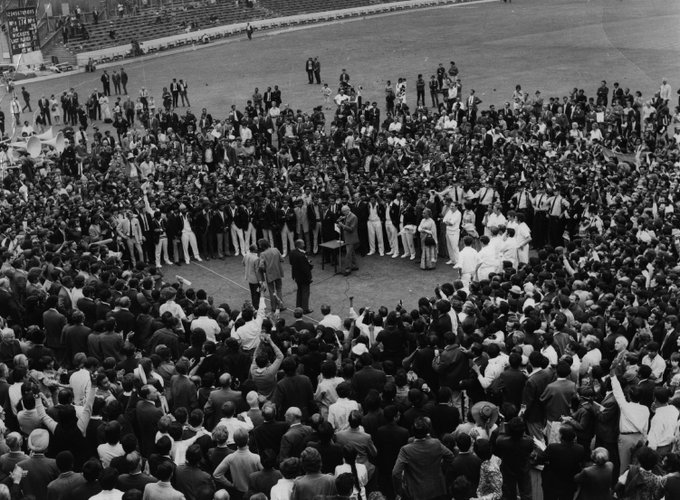
From the Archives
Little-known Controversies of Indian Cricket
One of the greatest victories in India’s cricket history was the 1971 series win against England in England. While Ray Illingworth, the English captain, was sounding the bugle, India had a series of problems going into the tour. All of a sudden, there was bad blood between the manager and the players, which could have impacted performance.
It started with the Bapu Nadkarni incident, which was barely reported in the Indian press. One reason for this may be the victory at the Oval, which helped mask differences and made sure the controversies were glossed over at the end of the series. It can be said with certainty that if an incident like this happened in 2023, each of India’s 100-plus news channels would have been on it all day, decoding the incident threadbare, passing verdicts and taking sides. Careers would be put on the line, and reputations trashed. The story would trend on social media for days, and the BCCI besieged for answers. Not so in 1971, when the incident was conveniently hushed up and swept under the carpet. In fact, most of the players I spoke to have no recollection of the incident, and expressed surprise that such a thing had taken place and was reported in the media. For almost all of them, England in 1971 remains the perfect memory, and anything that seeks to puncture holes in the perfect narrative is rejected outright. References to it are met with surprise and displeasure, and not many are willing to speak about it in detail.
Nadkarni, one of the most respected Indian cricketers, was playing club cricket for Ramsbottom in the Lancashire league at the time. For cricketers past their prime or those whose skillset was a rung lower than the national team, club cricket in England was a viable option to make a living. It was a substitute for something like the IPL and was looked upon as employment for entire generations of Test and first-class cricketers. This practice continued till the early 2000s, with many Indian cricketers playing for English clubs right through the summer. “I made significant money playing club cricket in the ’90s,” says Saradindu Mukherjee, one of Bengal’s premier spinners who had a relatively short India career in the early 1990s. “In those days, 20,000 GBP was a significant amount of money, and something that made a real difference to me and the family.”
In Nadkarni’s case, the club, in recognition of his services, decided to support him by organising a benefit match when the Indian team was playing the second Test at Old Trafford. The match was to be played on the Sunday in the middle of the Test, and in consultation with Hemu Adhikari, manager of the team, it was decided that the Indian players who weren’t playing the Test match would make guest appearances for Ramsbottom.
Adhikari, reports suggested, had spoken to the club officials and confirmed the arrangement. It was only after receiving formal confirmation from him that Ramsbottom went ahead, publicised the game and sold tickets for the fixture. On the Sunday, the club ground was packed to capacity, with a large section of the local community coming in to see the touring Indian players. There was much fanfare, and Nadkarni was there to receive the Indian players and soak in the moment.
Also Read: Dukes Ball Levels Playing Field in WTC Final
While Adhikari had confirmed the arrangements with Ramsbottom, he had done so without speaking to the players or to the BCCI. No formal permission had been sought, and it was highly unlikely that the BCCI would have agreed to such an arrangement in the middle of a Test match. All Adhikari did was inform the players, after which he left it to their discretion to attend the game or not. Fearing censure from the BCCI if they went ahead and played the game, the players decided not to turn up for the fixture.
Yet again, Adhikari did not communicate this to either Nadkarni or to the club. With the Indian players staying away, it was natural that the crowd, which had paid to watch the stars, turned restless and started hurling abuse at Nadkarni. For no fault of his, Nadkarni was in the firing line, and the incident caused him much embarrassment in front of the club and the thousands that had gathered to watch the game.
With the situation getting out of control, Nadkarni had to be rescued by club security and taken away from the ground. For someone who had served Indian cricket with distinction, this was an uncalled-for moment of embarrassment and humiliation. Subsequent reports on the incident mentioned two things – first, Adhikari should have been transparent with the club, and cleared the air on the players’ participation. Second, he should have spoken to the BCCI in advance, and sought permission to release players for the match.
For someone as respected as Nadkarni, the BCCI may have agreed to make an exception and allowed players to attend the game. Either way, this was a classic case of misunderstanding and miscommunication. Nadkarni was the big loser, and had to suffer public wrath while also missing out on much-needed financial support.
The players, for their part, were clear. Without formal permission from the BCCI, it wasn’t feasible to go and play in a fund-raiser in the middle of a Test match. Not only was that unheard of, it could also be construed as an act of indiscipline that invited sanctions from the Board. More importantly, it was a distraction they wanted to avoid in the middle of a series considered the most important of their lives. Some of them were worried about possible injuries, which could derail team plans ahead of the third and final Test match. While each of these reasons was logical, what is not known is why they did not communicate them to Nadkarni, which could have spared him ignominy on a day he was much looking forward to.
Also Read: Bhagwat Chandrasekhar at The Oval – An Indian Cricket Miracle
Either way, it created a misunderstanding between the players and Adhikari. Most players privately blamed him for the fiasco, and felt he should have been more forthcoming on the matter when it involved a former India international of the stature of Nadkarni. While on one hand, the result in the second Test at Old Trafford did not go in India’s favour, on the other the Nadkarni incident drove a wedge between members of the team management. The unity, which was evident from the start of the tour, was now being questioned and it was essential that Ajit Wadekar stepped up as leader to mask the cracks ahead of the most important game of the series.
The Nadkarni incident was an unnecessary distraction. Midway through the tour and especially after India had managed to keep the scoreline at 0-0, it was essential that the team was fully focussed on the enormity of the challenge that confronted them. In the 40 years that India had been touring England, no team had managed to draw a series, leave alone win it. This was a great opportunity based on what the team had managed to do at Lord’s, and incidents like the Nadkarni fiasco could take away players’ attention away from the immediate task on hand.
Adhikari, who had till then performed the manager’s role to perfection, was all of a sudden under the scanner. Comparisons with Keki Tarapore, who had done an excellent job in the West Indies a few months earlier, were inevitable. Adhikari had to win back the players’ trust, and in the middle of a tour with the pressure building, it was not an easy task to accomplish.
It was also a test of Wadekar’s leadership skills. With Adhikari by his side, it was easier to keep the flock together. Now, he had to do two things all on his own – first, he needed to keep the team together, and make sure there was no revolt brewing against the manager. Second, he needed to ensure the players’ support for Adhikari, so they could move past the incident as soon as possible. Added to these was the challenge of keeping the incident under the radar so that the hostile English media did not latch on to it and add to the pressure on the Indians ahead of the Oval Test.
Going by contemporary reports, Wadekar was successful in achieving each of the these objectives, and there was not a single report on the Nadkarni incident in the English press leading into the Oval Test. Also, Wadekar was conspicuously silent on the issue in his memoir ‘My Cricketing Years’, which he co-wrote with KN Prabhu. This may have been a deliberate decision, to ensure that the controversy remained buried and did not mar the narrative of success associated with that 1971 tour of England.
Also Read: India’s Batting Faces Acid Test in WTC Final




